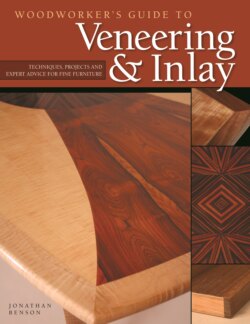Читать книгу Woodworker's Guide to Veneering & Inlay (SC) - Jonathan Benson - Страница 13
На сайте Литреса книга снята с продажи.
Wood figure and wood movement
ОглавлениеFigure refers to the visual patterns that appear on the surface of the wood (Figure 2-3). The patterns occur for a variety of reasons, including the wood fibers themselves, genetic mutation, disease, stress, or chance. Unusual figure sometimes appears when, for example, a crotch or feather pattern develops where two branches come together. Burls (Figure 2-4), cancerlike growths often caused by a wound or insect infestation, sometimes develop near the roots or on the trunk of a tree. When cut open, burls often have a complicated grain pattern that travels in all directions. Other processes, including genetic mutation, cause curl, swirl, blister, quilting, mottling, and bird’s-eye patterns (Figure 2-5 through 2-10), but do not appear in all species of wood. Still another type of figure occurs when a tree has grown on a hillside or has partially toppled but continues to grow, creating compression of the grain on the underside of the trunk, and stretching of the grain on the upper side (Figure 2-11).
Figure 2-3. Waterfall figure ripples across a sample of bubinga, a tropical hardwood from Africa. The unfinished sample is flat; the three-dimensional effect is due to light refraction.
Figure 2-4. Burl veneer shows the irregular edge of its growth. The white lines indicate where it will be cut for figure matching.
Figure 2-5. Fiddleback figure in makoré, a rare hardwood, resembles curl or fiddleback in American maple, though it is more richly colored. The book-matched samples here also show the reversal in light refraction from one side of the veneer leaf to the other.
Figure 2-6. In quilted mouabi, the reflective whorls arise from the wood grain curving in and out of the surface. The two leaves here are book-matched.
Veneer TERMS
Clip, clipped. The process of straightening the long edges of veneer leaves is called clipping.
Flitch cut. Flitch cutting is slicing the veneer from a log along its length or from a slab (like peeling a carrot).
Flitch. A stack of veneer sheets sliced from the log and kept in sequential order, so the grain and figure match from one leaf to the next, is called a flitch.
Leaf, leaves. Sheets of veneer are also called leaves.
Rotary cut. Using a sharp knife to peel the veneer from a round log, similar to paper towels unrolling, is rotary cutting. The process is used mostly to manufacture plywood from crosswise layers of veneers and is used to cover large plywood and MDF panels with decorative veneers.
Wood grain, grain pattern. Long fibers that make up wood are the wood grain. Grain runs in the direction of the tree trunk, but it can also run toward a cut surface, “with the grain,” or away from it, “against the grain.” Grain is a factor in how wood appears.
Wood figure, figure pattern. The wood figure is the appearance of wood influenced by knots, straightness of the tree trunk, color changes between heartwood and sapwood, stains caused by minerals and chemicals in the wood, and marks made by weather, insects, or other trauma throughout the tree’s life.
Figure 2-7. This African satinwood veneer shimmers due to the refractive properties of the wood grain.
Figure 2-8. Curly, or fiddleback, maple veneer will show as lighter and darker bands when finished.
Figure 2-9. Pomele sapele shows many small blisters or bird’s eyes in its figure. This sample is flat—the three-dimensional effect is entirely due to light refraction.
Figure 2-10. Quilted figure is also common in sapele and bigleaf maple.
Highly figured woods are rare and valuable. In addition, particularly with the burls and such unusual figure as curl, bird’s eyes, and quilting, the grain often has grown in many directions at the same time. The drying process and later seasonal expansion and contraction may cause the cut wood to split apart if not handled properly. One way to prevent splitting is to initially slice or saw these woods into thin veneers because veneers are inherently more stable than thicker solid wood.
Many design and construction situations do not allow for any wood movement. Methods to compensate for movement in solid wood construction are limited. Quarter-sawing lumber is one such method. Quartersawn wood moves less in width and more in thickness, but because the boards are relatively thin compared to their width, wood movement is less of a problem. Another solution to wood movement involves frame-and-panel construction. In this method, a panel is placed in a groove within a frame and allowed to float without being glued in place. Floating allows the panel to expand and contract across its width without affecting the overall dimensions of the frame. Veneer offers another approach to dealing with wood movement that allows for much more design flexibility. When thin veneers are securely glued to a stable surface (called a substrate), any movement across the grain is nearly eliminated. (For a complete discussion of substrates, please see Chapter 4).
Figure 2-11. The leaning trunk of this black cherry tree shows compression rippling, which will appear as curl in the wood cut from it.
